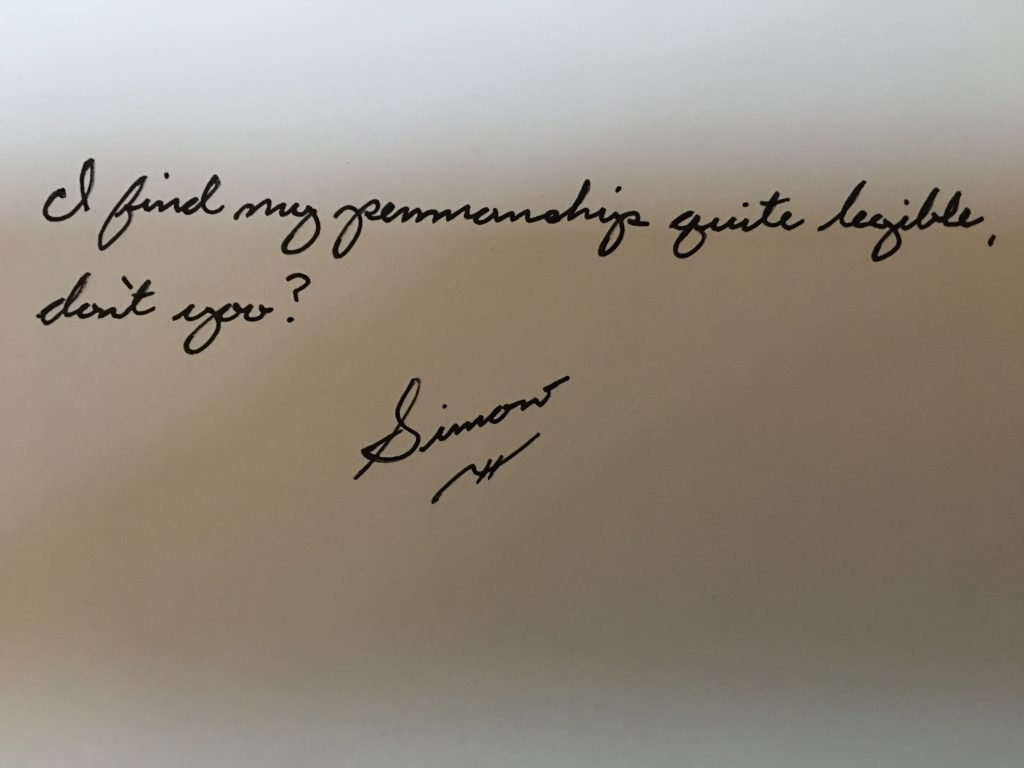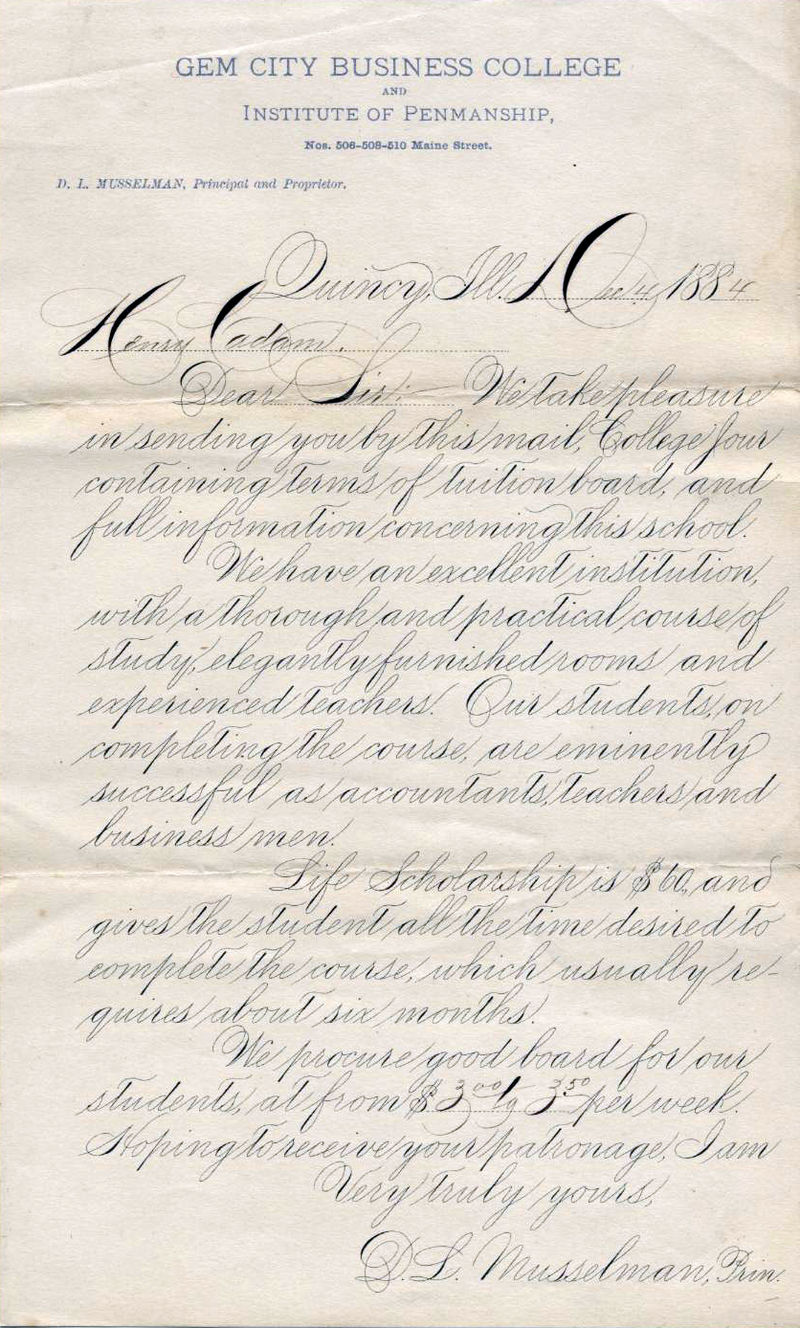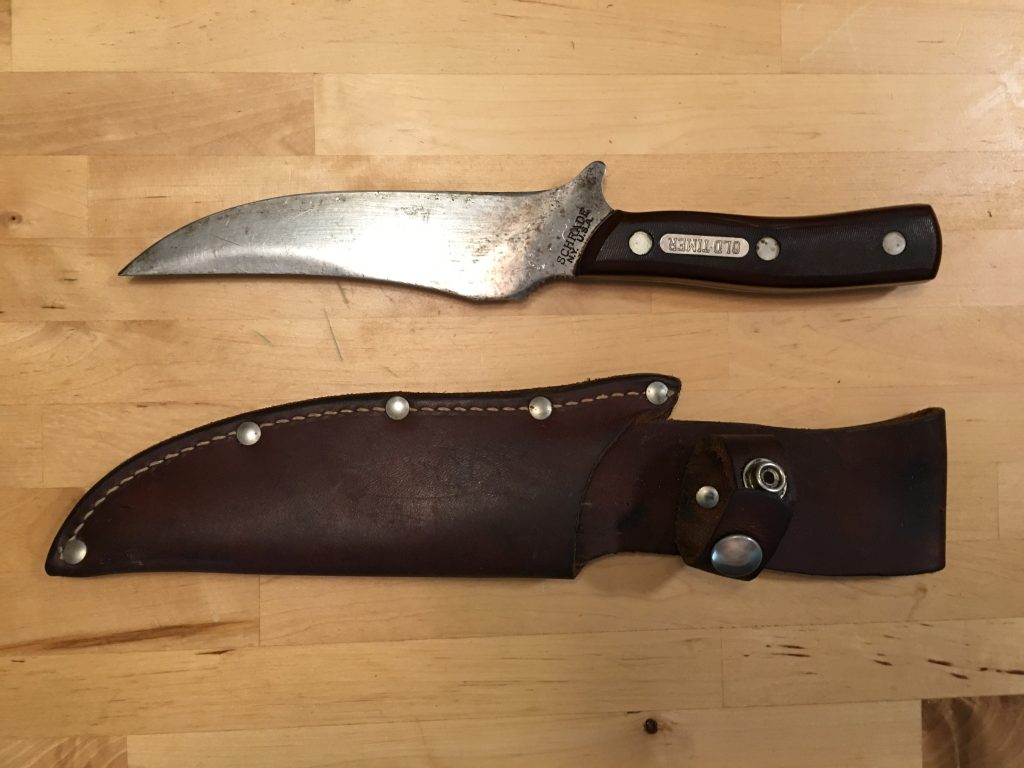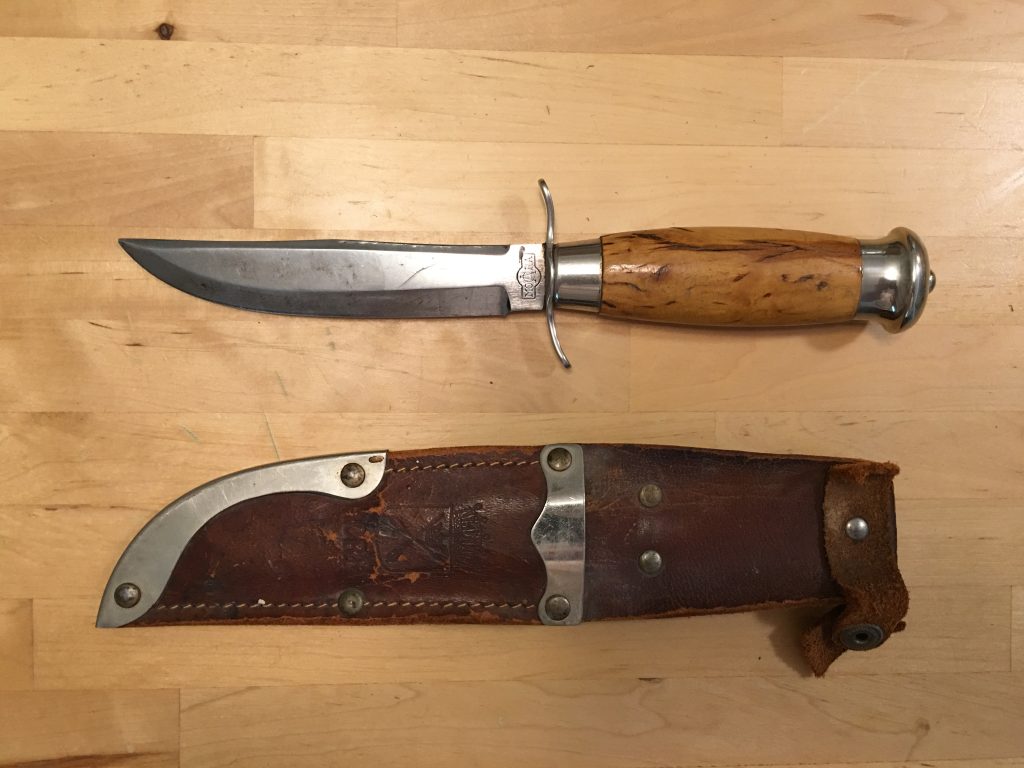A post link to a new static page:
–Simon

Because the thought occurred now and it might be gone tomorrow
I’ve always fancied cursive. However, my contemporaries, as well as my teachers, hated it. Yet, it remained in the curriculum back in the early 90s regardless. And while it might now be falling into the myriad of lost/obsolete skills, I refuse to let it die completely.
Amusingly, because so many have written it off (hehe), so few are able to readily even read it. I’ve even been asked on occasion to stop. But I look back on my college years and note that none of my professors ever had the slightest hint of difficulty reading my writing, and were it not for my adeptness with the seemingly ancient script, those lengthy hand-written final exam essays would have been much more difficult. So I say unto these people: No! Learn how to read!
But many today too predict the impracticality of modern higher education–that it will collapse under its own unsustainability and become less higher, and more vocational. College, like cursive, will become an academic relic.
Apparently, I can be pompous and nihilistic. That seems to suit me.
The irony of blogging about handwriting is not lost on me, and I still on occasion relish the pure analog methods. And in this I am certainly not alone, for I listened to a recent podcast that discussed the history of penmanship at length. The host (approximately my age) mentioned that he had been taught the D’Nealian method, and this got me curious, for I had never considered the type of cursive that I use. It seemed like a good time to find out.
So I took a sample of my writing for the base comparison:

In an attempt to remove bias (which I’m sure isn’t perfect), I wrote a sentence as automatically as possible, so as to preserve the natural form of the letters. Then I compared it to the D’Nealian alphabet:

It didn’t seem quite the same, so I wrote out the alphabet as I would normally make the letters:

There were a lot of similarities, but it wasn’t quite the same, mostly in my upper case characters. Mine had more loops and flair. I wondered why that was? I doubt that’s something I would have picked up on my own, so where did it come from? Time to dig further back.
D’Nealian was apparently an attempt to ease the transition between cursive and print. Prior to this, we had Zaner-Bloser.
There appeared to be variations with Zaner-Bloser, and most of the modern samples I found strongly resembled D’Nealian, but I did find this sample, which included the loops that I use:

In fact, it used more loops than I use. So it would appear that I was taught during some transitional period wherein I developed a Zaner-Bloser/D’Nealian hybrid. But from where did Zaner-Bloser orginate?
Apparently, from the Palmer Method:

Palmer varied significantly from my method–not just in loops, but is some examples of fundamental character structure, notably the F, R, and T.
And just to complete this line of inquiry, I dove back one iteration further–Spencerian:

Spencerian was ridiculously loopy, and even incorporated shading accents. It was an obvious predecessor, but certainly nothing that would be taught in gradeschool.
I conclude then, that my cursive writing style is founded on Plamer, which had been modified into Zaner-Bloser. But at some point in my learning, the style had changed to D’Nealian. I do recall at one point there being a discussion with my teacher that I was using unsanctioned loops, which I specifically recall having been previously taught to use, so there was apparently no formal cutoff between the two styles, and I had been taught both–ultimately resulting in the hybrid style I use today, which might be fairly unique in its own right.
The modern equivalent is the evolution of fonts. Monospaced fonts, created for efficiency and their lack of computing resource demand, gave way to variable-width serif fonts, which were created to be easier to read in print, which gave way to sans-serif fonts, supposedly easiest to read on the variety of modern computer screens. At one point I was instructed to type all manuscripts in size 12 Times New Roman–a variable-width serif font–yet the standard now is Arial. Who knows–maybe one day someone 10-20 years my junior will lament on the passing of serif fonts much the way I’m lamenting now on the obsolescence of handwritten cursive.
In loving memory
Cursive
–Simon
As a non-football watcher, I’ve spent many a conversation pretending to have watched something I didn’t, or to care about something I don’t, and to use grammatically unsound complex sentences of negation.
At first, I would maintain the charade as football fans, when discussing football, are complete conversational narcissists, and would never notice that I wasn’t adding anything meaningful to the conversation. These one-sided discussions would invariably crescendo to an emotionally-charged climax, upon which I would just agree with whatever was said last and laugh, which in turn led to some mutual conclusion that escaped me because I don’t watch football.
Now, I just don’t care enough about garnering favor with random people at the coffee station, so I don’t humor the smalltalk anymore, or so was my intent. Unfortunately, a surprising majority of people take the dismissive comment to be a joke (for what kind of American doesn’t watch football?), and interpret it as encouragement–thus putting me into the conversation anyway.
So I decided that, as it’s been said: If you can’t beat ’em–kill everyone. Or rather, inwardly sigh sadly and pretend to follow along. But I need assistance. I need information…obtained through any other means than reading, watching TV, or conversing with my fell Man.
I needed an aggregator and summarizer. I needed the absolute bare minimum content required to form a cohesive thought. I needed the equivalent of a Twitter feed of sports commentary, but without the racism/sexism/homophobia (the entire social aspect, basically). I needed a means by which to trawl football articles and identify the most-used words, negating general sentence structure such as definite articles and conjunctions.
Fortunately I found this site: wordcounter.net. Probably not its intended use–I began pasting the top football news articles into its form and analyzing their content. I checked 5 such posts, and compiled their keywords:

Okay, I could work with this. This Bryant fellow seems to be a highlight. I’m sure I could muddle through the rest.
I decided to test my theory on Liz, and texted her the following message:
“I heard that in Bryant’s week one, he scored enough points that it’ll be his big season. He’ll make a good five-star Fantasy Football pick. Despite the initial loss, Arkansas will recover with enough victories to stay in the running.”
Liz responded:
“What are you reading?”
She was intrigued! Had I pulled it off?! I replied, ambiguously:
“Just the highlights.”
She validated my success by sending me an unrelated photo of a dog that was up for adoption.
…Okay, maybe my method needs a little refinement. Maybe I can pull a larger sampling of articles and write a formula to analyze the character strings.
Or maybe, just maybe…when I tell you I don’t watch football you could stop talking to me about football and I wouldn’t have to design a logic-based analysis of textual media to formulate responses to your banal and pointless rambling. Now quit hogging the coffee machine.
–Simon
My father was a farmboy. I’ve mentioned this before, but it warrants repeating. And I’m doing so because, amongst my contemporaries, having such a parent of this surprisingly uncommon background often creates discord when discussing what are “normal” habits and skillsets (as in, people really don’t like to go outside much).
One specific example–a debate which I frequently have–is the practice of carrying knives. My generation, the one that brought the world Columbine and the now apparently commonplace practice of mass shootings, developed a certain aversion to any form of weapon. Among these: knives. Even though, despite the association of knives with murder, most knives aren’t even designed to be effective at such a task. No–they’re tools, and the most versatile tools in existence (except anything marketed as “tactical”–an immediate sign that the knife is useless).
My father naturally always understood this, and saw fit that I did as well. So when I was 6, he gave me an Old Timer, canoe-style–probably the first kind of knife that every boy receives. And with it I also received the expected rundown on knife safety and proper use…and naturally cut myself repeatedly while disregarding this guidance. But I learned through trial and error, and despite having long-since lost that first knife (still sad about that), I’ve maintained the practice of always carrying a knife (except during those post-Columbine years where I had to pass through a metal detector at school each morning). And even now, in this absurd period of chronic “preparedness” and the Internet awash with articles on proper EDC (every-day carry) loadouts, when people wear braided bands of paracord on their wrists because “you never know when that 3 feet of string could save your life”, people still don’t carry knives. But I’m rambling. In short, I appreciate a good knife and, like my father, collect (and lose) them.
I also have a tendency to break them. The steel used in modern knives is invariably stainless. That’s fine for light use, and much lower-maintenance, but it’s too brittle and doesn’t hold up to punishment. And, they don’t seem to hold as sharp an edge–filing them down too far apparently breaks off the leading edge, so they can be generally sharp, but not really sharp. So the next time I found myself in a sporting goods store, I looked for a carbon variant. And, there were none.
So I asked the Old Man for input. Unfortunately, to his knowledge, carbon steel blades had been essentially phased out with modern designs, so if I were to acquire one, it wouldn’t be a convenient flip knife, and I’d have to shop around for an old one–“vintage”, as we affectionately call old things that are still desirable. I put the thought on hold as low priority.
Then Dad gave me a box of goodies. In it were arrowheads (for when I decide to finally shoot the neighbor’s kid), and a selection of knives. Two of these knives, fixed blades, immediately caught my fancy. They were certainly oxidized, but only in that they had a patina–no rust. They were also nicely sharp and didn’t need much attention. A few swipes with the ceramic, then the steel, and they were razors. I oiled them and set them on the table. They were cool, and functional, and obviously had some history behind them.
And I wanted to know more, so I spent a few hours researching. So, for any knife aficionados/historians, I will naturally share the results of my efforts. I haven’t vetted my sources, but I imagine they’re more or less accurate based on the lack of inconsistency:
#1: Schrade Old Timer 15OT

It was obvious from the look and feel that this was a large game hunting knife. It was also stamped with the model number, which made it easy to find (which also confirmed my assessment). It’s marketed as the Deerslayer.
Surprisingly, I couldn’t easily find a comprehensive backstory of the Old Timer brand. Currently, the IP is owned by Taylor Brands LLC, though it was formerly an Imperial Schrade brand (as Schrade Walden Cutlery Corporation) , who shut down in 2004. Prior to Taylor Brands LLC, Imperial Schrade had acquired the Schrade Cutlery Company, which itself dates back to its founding in 1903, so I’m assuming that the Schrade Cutlery Company was the Old Timer’s origin, though I can’t find this explicitly confirmed. And Schrade’s own history has a number of confusing business deals: licensing, asset sell-offs, ownership changes, etc., so the final verdict might be lost to time, or up for debate.1,2
But the knife was definitely not this old. I tracked down any info I could on the specific markings. The brand name wording and location of the stamps (no doubt a result of the aforementioned business deals), dates the blade to the later end of Schrade’s time, before Imperial Schrade Corp.’s 1985 consolidation/name change. I can’t nail down the exact timeframe, but it appears to be from 1974-1985, though it could be as late as the 1990s.
However, Dad mentioned that he found the knife while hiking, and based off of the relative time of that fateful event, I’d hazard to guess that this initial 11-year period estimate is accurate.
So to summarize, this knife is a model 15OT; manufactured by Schrade as the Schrade Walden Cutlery Corporation, under Imperial Knife, but prior to Imperial Schrade Corp., between 1974-1985; as part of the Old Timer line, and marketed as the Deerslayer. Not a bad find, and I can empathize with whoever lost it.
#2: Carl Anderssons Morakniv Jaktdolk Nr 29 B

This second knife sported a multipurpose field design, similar to the Ka-Bar, though more stylized than a true combat knife. Its origin was also incredibly difficult to track down, though well worth the virtual journey.
I had a lot less to go on, too. The blade and scabbard were both stamped with the label “MORA”, with the scabbard including a symbol akin to a coat of arms, while the blade also included a C and A transposed over each other in the center of the MORA name (and what I eventually assumed to stand for “Carl Anderssons”). The right side of the blade was also stamped with “MADE IN SWEDEN”.
The trouble was that the MORA name didn’t indicate the manufacturer, but as it turns out, the city of Mora, Sweden wherein a variety of knife manufacturing companies operate. And as the knife did not include a model number, I had to go through each of the companies’ offerings.3
This was further complicated in that the name “Mora” no longer meant necessarily that the company was based in Mora, but rather Mora now indicates a style of knife, though still Swedish in origin.
During my research, the knife-wielding community spoke very highly of Mora knives. They were in agreement that Mora knives were of exceptional build quality and insanely cheap given what they offer. They’re also never found in American retailers, and have to be ordered. World economics make little sense to me sometimes. So American steel collapsed and everything’s imported from the lowest bidder, which of course means really cheap steel that breaks, but it’s still given a massive markup when they hit retailers, so I’d be spending twice on something significantly inferior to what I could order myself from Sweden. I even stumbled across a Boy Scout troop’s website during my search, and the scoutmaster was writing about how he orders Mora blades in bulk for the troop. So the Boy Scouts of America are using Swedish blades…
Naturally, these anecdotes only served to add legitimacy to my original displeasure with the stainless steel knives I had been using. Nice to know that I’m not alone.
Anyway, my search had hit a dead end, having found hundreds of knife designs but nothing that truly matched. But then I had the idea to try to find an image of the logo–the one stamped into the leather sheath. And, by the grace of search engine algorithms, I found a very close (though not exact) match.
I followed the image to its hosting site and discovered, with much elation, that the company who owned that matching logo (Morakniv) had preserved an archive of their catalogs.4
And there, on page 27 of their 1942 catalog, was the match. I went through all their catalogs, just in case, but there could be no doubt. Their next catalog in chronology was dated 1957, so that gives us the date range. The wooden handle and blade length probably preclude it from having been a Swedish WWII combat knife, but it’s fun to entertain the thought that it was around in those days, long before I ever came to be.
Morakniv apparently had its origins as a watch manufacturer, but abandoned watches in 1898 as that industry became dominated by America (go figure). So the owner switched initially to making wagon wheels, then to knives–an interesting and unintentional fate for a factory responding to supply and demand. The wiki site was in Sweedish, so I had to rely on Google Translator for this info.5
So to recap, this knife is a model Jaktdolk Nr 29 B; manufactured by Carl Anderssons Morakniv of Mora, Dalarna, Sweeden, between 1942 and 1957.
I’ve taken to carrying this one around the yard, though it’s a little big for gardening tasks such as harvesting cucumbers. But despite its age, it’d seem a shame to simply stash the thing in a drawer until I forgot about it, so I’d rather add to its lengthy and unknown history.
Dad says he picked it up at a garage sale, and I’d have to say that was an incredible find.
Ultimately, it’s not major crisis if a knife breaks “in the field”, as that simply constitutes my backyard, but it sure is annoying. I’m looking forward to giving these old carbon blades a try.
Thanks Dad!
–Simon
1https://www.knivesplus.com/OLD-TIMER-KNIVES.HTML
2https://en.wikipedia.org/wiki/Imperial_Schrade
3https://en.wikipedia.org/wiki/Mora_knife
4https://morakniv.se/en/vintage-catalogs
5https://sv.wikipedia.org/wiki/Morakniv